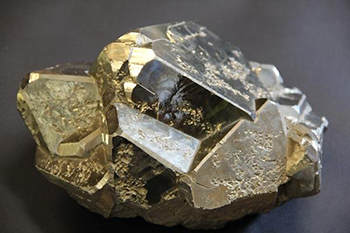
This crystal of iron pyrite shows the characteristic cubic crystals of fool's gold. Credit: University of Wisconsin-Madison Geology Museum
A team of researchers at the University of Wisconsin-Madison, USA, have dug deep into the structure of iron pyrite—an earth-abundant material also known as fool’s gold—to uncover defects that prevent its use in commercial photovoltaic (PV) solar cells (J. Am. Chem. Soc., doi: 10.1021/ja509142w). Knowing why iron pyrite fails to generate a voltage could help scientists correct its crystalline structure and use it to replace more expensive silicon films.
In theory, iron pyrite (FeS2) has the potential to achieve terawatt-scale solar energy deployment with a film 1,000 times thinner than commonly used silicon; but when tested in real-life, solar cells with iron pyrite films produced almost no voltage. To figure out why, professor Song Jin’s team not only looked at the crystal’s surface structure, which many other groups have studied, but also investigated the “heart” of the material. They began by creating a circuit model analysis for the electrochemical impedance spectroscopy of single iron pyrite crystals. This model enabled them to characterize surface and inner defects and construct a detailed band-energy diagram of individual crystals. The team discovered that the surface defects alone were not the cause of the low photovoltage. Deep inside the iron pyrite crystal, even in ultra-pure samples, sulfur atoms were missing from their expected place in the structure. In large enough numbers, these “bulk defects” are what prevent the iron pyrite crystals from generating a voltage.
The authors believe that if scientists can find a way to synthesize crystals without these bulk defects, iron pyrite films for PV solar cells could replace the industry-standard silicon films, allowing for dramatic cost savings in materials and installation. Such knowledge could also be used to evaluate and improve other next-generation solar materials.
